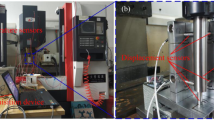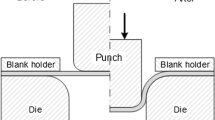Abstract
This paper addresses the challenges of traditional spindle assembly methods, which rely on trial-and-error approaches, hindering new product development evaluation. A stacking ensemble model is proposed to predict the assembly quality variation of machine tool spindles. The model uses data from 925 single-spindle inspections and extracts evaluation metrics from multiple domains to extract valuable information. Feature selection is performed using a correlation model to identify important features, and various lightweight supervised learning algorithms are applied to analyze the data. To further enhance the model’s performance, a stacking ensemble approach is proposed, which combines algorithms. The results demonstrate that the proposed stacking ensemble model is an effective approach for predicting the assembly quality variation of machine tool spindles, using the data available. The proposed ensemble model enhances quality control processes in spindle assembly, enabling practitioners to identify key features and predict machine tool spindle assembly quality variations more accurately.












Similar content being viewed by others
References
Li H, Wang Y, Ran Y, Zhang G (2019) Optimal analysis of performance improvement strategy for mechanical system assembly process based on fault tree model. IEEE Access 7:76438–76447
Pereira J, Vilà M (2015) An exact algorithm for the mixed-model level scheduling problem. Int J Prod Res 53(19):5809–5825
Balamurali et al (2019) An optimal robotic assembly sequence planning by assembly subsets detection method using teaching learning-based optimization algorithm. IEEE Trans Autom Sci Eng 15(3):1369–1385
Kannan SM, Jayabalan V (2001) A new grouping method to minimize the surplus parts in selective assembly for complex assemblies. Int J Prod Res 39(9):1851–1864
Kannan SM, Jayabalan V (2003) Genetic algorithm for minimizing assembly variation in selective assembly. Int J Prod Res 41(14/20):3301–3313
Kannan SM, Asha A, Jayabalan V (2005) A new method in selective assembly to minimize clearance variation for a radial assembly using genetic algorithm. Qual Eng 17(4):595–607
SharmaS, Biswal BB, Dash P, Choudhury BB (2008) Generation of optimized robotic assembly sequence using ant colony optimization. Proceedings of IEEE International Conference on Automation Science and Engineering, IEEE, pp 894–899
Smith GC, Smith SS-F (2002) An enhanced genetic algorithm for automated assembly planning. Robot Comput Integr Manuf 18(5):355–364
Lu C, Yang Z (2016) Integrated assembly sequence planning and assembly line balancing with ant colony optimization approach. Int J Adv Manuf Technol 83(1):243–256
Tsai J-C, Wu S-R (2013) Tolerance analysis and re-distribution of a machine tool spindle by negative tolerancing. Procedia CIRP 10:267–270
Pop A-C, Pinto DE, Tuchsen J, Koch M (2020) Robustness to large-scale mass production manufacturing tolerances by means of sensitivity and statistical analysis for IPMSMs. IEEE Trans Energy Convers 35(4):2201–2209
Mo W, Du X, Liu S, Jin S (2022) Tolerance analysis and allocation of precision rotary table based on Jacobian-Torsor statistical model. In World Conference on Mechanical Engineering and Intelligent Manufacturing (WCMEIM). IEEE, pp 330–334
Wu X, Zhao J, Tong Y (2018) Big data analysis and scheduling optimization system oriented assembly process for complex equipment. IEEE Access 6:36479–36486
Jardine AKS, Lin D, Banjevic D (2006) A review on machinery diagnostics and prognostics implementing condition-based maintenance. Mech Syst Signal Process 20(7):1483–1510
Malhi A, Gao RX (2004) PCA-based feature selection scheme for machine defect classification. IEEE Trans Instrum Meas 53(6):1517–1525
Van M, Kang H-J (2015) Wavelet kernel local Fisher discriminant analysis with particle swarm optimization algorithm for bearing defect classification. IEEE Trans Instrum Meas 64(12):3588–3600
Soualhi A, Medjaher K, Zerhouni N (2015) Bearing health monitoring based on Hilbert-Huang transform support vector machine and regression. IEEE Trans Instrum Meas 64(1):52–62
Yuan L, He Y, Huang J, Sun Y (2010) A new neural-network-based fault diagnosis approach for analog circuits by using kurtosis and entropy as a preprocessor. IEEE Trans Instrum Meas 59(3):586–595
Benkedjouh T, Medjaher K, Zerhouni N, Rechak S (2012) Fault prognostic of bearings by using support vector data description. Proceedings of IEEE Conference on Prognostics and Health Management (PHM). IEEE, pp 1–7
Ren L, Lv W, Jiang S, Xiao Y (2016) Fault diagnosis using a joint model based on sparse representation and SVM. IEEE Trans Instrum Meas 65(10):2313–2320
Ge M, Xu Y, Du R (2008) An intelligent online monitoring and diagnostic system for manufacturing automation. IEEE Trans Autom Sci Eng 5(1):127–139
Sugumaran V, Ramachandran KI (2007) Automatic rule learning using decision tree for fuzzy classifier in fault diagnosis of roller bearing. Mech Syst Signal Process 21(5):2237–2247
Pandya DH, Upadhyay SH, Harsha SP (2013) Fault diagnosis of rolling element bearing with intrinsic mode function of acoustic emission data using APF-KNN. Expert Syst Appl 40(10):4137–4145
Shen F, Chen C, Yan R, Gao RX (2015) Bearing fault diagnosis based on SVD feature extraction and transfer learning classification. Proceedings of Prognostics and Systems Health Management Conference (PHM). IEEE, pp 1–6
Priore P, Ponte B, Puente J, Gómez A (2018) Learning-based scheduling of flexible manufacturing systems using ensemble methods. Comput Ind Eng 126:282–291
Xu X, Liu S, Wei X, Wang C (2021) Deep learning-based tool wear prediction and its application for machining process using multi-scale feature fusion and channel attention mechanism. Measurement 177:109254
Li H, Hu G, Li J, Zhou M (2022) Intelligent fault diagnosis for large-scale rotating machines using binarized deep neural networks and random forests. Int J Mach Tools Manuf 19(2):1109–1119
Lela B, Bajić D, Jozić S (2009) Regression analysis, support vector machines, and Bayesian neural network approaches to modeling surface roughness in face milling. Int J Adv Manuf Technol 42:1082–1088
Gabsi AEH, Ben Aissa C, Mathlouthi S (2023) A comparative study of basic and ensemble artificial intelligence models for predicting surface roughness in the AA7075 milling process. Int J Adv Manuf Technol 126:1–15
Gupta AK, Guntuku SC, Desu RK et al (2015) Optimisation of turning parameters by integrating genetic algorithm with support vector regression and artificial neural networks. Int J Adv Manuf Technol 77:331–339
Chandrasekaran M, Muralidhar M, Krishna CM et al (2010) Application of soft computing techniques in machining performance prediction and optimization: a literature review. Int J Adv Manuf Technol 46:445–464
Gao Z, Zhang H, Ding H, Xue S (2019) Resonance speed measurement of high-speed spindle using an instruction-domain-based approach. Meas Sci Technol 30(5):055006
Hung JP, Lai YL, Luo TL, Su HC (2013) Analysis of the machining stability of a milling machine considering the effect of machine frame structure and spindle bearings: experimental and finite element approaches. Int J Adv Manuf Technol 68(9–12):2393–2405
Zhang SJ, To S, Zhang GQ, Zhu ZW (2015) A review of machine-tool vibration and its influence upon surface generation in ultra-precision machining. Int J Mach Tools Manuf 91:34–42
Abdelkhalek A, Mashaly M (2023) Addressing the class imbalance problem in network intrusion detection systems using data resampling and deep learning. J Supercomput 79:10611–10644
Ullah A et al (2022) Adaptive data balancing method using stacking ensemble model and its application to non-technical loss detection in smart grids. IEEE Access 10:133244–133255
Bergstra J, Bengio Y (2012) Random search for hyper-parameter optimization. J Mach Learn Res 13(2):281–305
Pontes FJ, Amorim GF, Balestrassi PP, Paiva AP (2016) Design of experiments and focused grid search for neural network parameter optimization. Neurocomputing 186:22–34
Jiang S, Mao H (2010) Investigation of variable optimum preload for a machine tool spindle. Int J Mach Tools Manuf 50(1):19–28
Li W et al (2022) A novel methodology for lens matching in compact lens module assembly. IEEE Trans Autom Sci Eng 20(2):741–750
Funding
This work was supported in part by the Advanced Institute of Manufacturing with High-tech Innovations (AIM-HI) from The Featured Areas Research Center Program within the framework of the Higher Education Sprout Project by the Ministry of Education (MOE) in Taiwan and was also supported in part by the Ministry of Science and Technology, Taiwan, ROC, under Grant NSTC 112–2218-E-194–007.
Author information
Authors and Affiliations
Contributions
ML developed the theory and carried out the simulations and experiments under the supervision of SC and PK. Three authors participated in the analysis and interpretation of the data. The manuscript was originally drafted by ML, and reviewed and edited by SC and PK. All three authors read and approved the final manuscript.
Corresponding author
Ethics declarations
Ethic approval
Not applicable.
Consent to participate
Not applicable.
Consent for publication
Not applicable.
Conflict of interest
The authors declare no competing interests.
Additional information
Publisher's Note
Springer Nature remains neutral with regard to jurisdictional claims in published maps and institutional affiliations.
Rights and permissions
Springer Nature or its licensor (e.g. a society or other partner) holds exclusive rights to this article under a publishing agreement with the author(s) or other rightsholder(s); author self-archiving of the accepted manuscript version of this article is solely governed by the terms of such publishing agreement and applicable law.
About this article
Cite this article
Liu, MS., Kuo, PH. & Chen, SL. Prediction of machine tool spindle assembly quality variation based on the stacking ensemble model. Int J Adv Manuf Technol (2024). https://doi.org/10.1007/s00170-024-13766-7
Received:
Accepted:
Published:
DOI: https://doi.org/10.1007/s00170-024-13766-7




